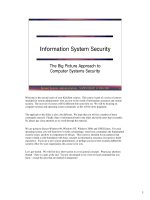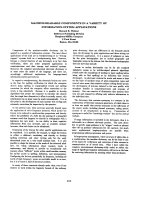Information system ralph CH03
Bạn đang xem bản rút gọn của tài liệu. Xem và tải ngay bản đầy đủ của tài liệu tại đây (733.13 KB, 53 trang )
Fundamentals of Information
Systems, Fifth Edition
Chapter 3
Database Systems and Business
Intelligence
Principles and Learning Objectives
• Data management and modeling are key aspects
of organizing data and information
– Define general data management concepts and
terms, highlighting the advantages of the database
approach to data management
– Describe the relational database model and outline
its basic features
Fundamentals of Information Systems, Fifth Edition
2
Principles and Learning Objectives
(continued)
• A well-designed and well-managed database is an
extremely valuable tool in supporting decision
making
– Identify the common functions performed by all
database management systems, and identify popular
database management systems
Fundamentals of Information Systems, Fifth Edition
3
Principles and Learning Objectives
(continued)
• The number and types of database applications will
continue to evolve and yield real business benefits
– Identify and briefly discuss current database
applications
Fundamentals of Information Systems, Fifth Edition
4
Data Management
• Without data and the ability to process it
– An organization could not successfully complete
most business activities
• For data to be transformed into useful information,
it must first be organized in a meaningful way
Fundamentals of Information Systems, Fifth Edition
5
The Hierarchy of Data
• Bit
– Circuit that is either on or off
– Eight bits = one byte
• Character
– Basic building block of information
• Field
– Name, number, or combination of characters that
describes an aspect of a business object or activity
Fundamentals of Information Systems, Fifth Edition
6
The Hierarchy of Data (continued)
• Record
– Collection of related data fields
• File
– Collection of related records
• Database
– Collection of integrated and related files
• Hierarchy of data
– Bits, characters, fields, records, files, and databases
Fundamentals of Information Systems, Fifth Edition
7
Fundamentals of Information Systems, Fifth Edition
8
Data Entities, Attributes, and Keys
• Entity
– Generalized class of people, places, or things for
which data is collected, stored, and maintained
• Attribute
– Characteristic of an entity
• Data item
– Value of an attribute
Fundamentals of Information Systems, Fifth Edition
9
Data Entities, Attributes, and Keys
(continued)
• Key
– Field or set of fields in a record that is used to
identify the record
• Primary key
– Field or set of fields that uniquely identifies the
record
Fundamentals of Information Systems, Fifth Edition
10
Fundamentals of Information Systems, Fifth Edition
11
The Database Approach
• Traditional approach to database management
– Separate data files are created and stored for each
application program
• Database approach to database management
– Multiple application programs share a pool of related
data
Fundamentals of Information Systems, Fifth Edition
12
Fundamentals of Information Systems, Fifth Edition
13
Fundamentals of Information Systems, Fifth Edition
14
Fundamentals of Information Systems, Fifth Edition
15
Data Modeling and Database
Characteristics
• When building a database, consider:
– Content: What data should be collected, at what
cost?
– Access: What data should be provided to which
users and when?
– Logical structure: How should data be arranged to
make sense to a given user?
– Physical organization: Where should data be
physically located?
Fundamentals of Information Systems, Fifth Edition
16
Data Modeling
• Building a database requires two types of designs
– Logical design
• Abstract model of how data should be structured and
arranged to meet an organization’s information needs
– Physical design
• Fine-tunes the logical database design for
performance and cost considerations
Fundamentals of Information Systems, Fifth Edition
17
Data Modeling (continued)
• Planned data redundancy
– Improves system performance
• Data model
– Diagram of data entities and their relationships
• Enterprise data modeling
– Data modeling done at the level of the entire
enterprise
• Entity-relationship (ER) diagrams
– Data models that use basic graphical symbols to show
the organization of and relationships between data
Fundamentals of Information Systems, Fifth Edition
18
Fundamentals of Information Systems, Fifth Edition
19
The Relational Database Model
• Relational model
– Describes data using a standard tabular format
– Data elements are placed in two-dimensional tables,
called relations, the logical equivalent of files
• Domain
– Allowable values for data attributes
Fundamentals of Information Systems, Fifth Edition
20
Fundamentals of Information Systems, Fifth Edition
21
Manipulating Data
• Selecting
– Eliminates rows according to criteria
• Projecting
– Eliminates columns in a table
• Joining
– Combines two or more tables
• Linking
– Combines two or more tables using common data
attributes
Fundamentals of Information Systems, Fifth Edition
22
Fundamentals of Information Systems, Fifth Edition
23
Fundamentals of Information Systems, Fifth Edition
24
Database Management Systems
(DBMS)
• Group of programs used as an interface between a
database and application programs or a database
and the user
• Used to manage all kinds of data for all kinds of
purposes
Fundamentals of Information Systems, Fifth Edition
25









